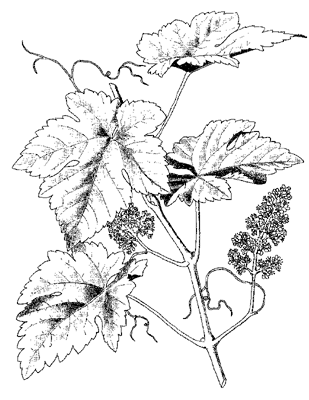Grape seed oil


Originally from Asia Minor, vine spontaneously grows in southern Europe, in North Africa and in the Middle East. It is nonetheless quite commonly cultivated. Vine is a sarmentose shrub. Its trunk, the bark of which removes in strips, can reach one metre in circumference at its base, and the branches can be 30 metres long. Its climbing stem has tendrils opposite to the leaves. These latter, lobed, heart-shaped at their base, hairy on their underside, have a petiole. In June, the small greenish regular odorous flowers are packed in compact inflorescences, opposite to the leaves. In September-October, the fruit or grapes are ripe : they are ovoid or globular clustered berries containing the seeds called pips. Grape is used in medicine in all its forms and produces. The Ancients used grape, once the seeds had been removed, as a softener for illnesses related to trachea, lung, kidney, bladder and liver. The fresh juice or must of ripe grapes was considered, with good reason, as diuretic and laxative, but the School of Salern denounced the swellings it caused : "Provocat urinam mustum, cito solvit et inflat". Dioscorides already used the juice of unripe grape, called "verjus", as a refrigerant in raging fevers, for tonsillitis, mouth ulcers and also against blood-spitting. Useful to preserve from plague, it was successfully tried out to fight hepatic flows. Wine is extracted from grapes after alcoholic fermentation. Doctors, Pasteur first, consider that wine drunk in moderation can be recommended to people older than twenty. Wine is nowadays advised to people older than 50 ; thus taking up on the "French paradox" along with other ingredients of the French "cuisine". Wine and alcohol played an essential role in the evolution of medicine, notably as solvents for many organic substances. From this their privileged use as bases for maceration, decoctions and other medicinal preparations, which still exists in all our traditional medicines ("elixir of the Hungarian Queen", tincture of arnica, absinth wine). Grape can be eaten in many ways : raw, cooked as trimmings, in jam or grape jelly. Above all, wine is extracted from grape, a technique that became a real art through time. The Arabs invented the alcohol or "spirit of wine", distilled out of it. Arnaud de Villeneuve, doctor and alchemist of the 13th and the 14th centuries, introduced it in Europe.
Vitis comes from "viere", to link, because of its tendrils and "vinifera", because it gives wine. Some authors would like "vitis" to come from the Latin vita, meaning life. Vine is one of the most ancient cultivated plants. The Greeks and the Egyptians knew it and the leaves found in temples and houses testify that vine was an ornamental plant. It seems like wine has always existed but it was not until 600 years before our era that Greeks from Phocea reached Marseilles and taught the Gauls how to graft wild vine and make wine. Vineyards then spread, the Gauls invented the barrel and appreciated wines travelled to Rome. Roman legionaries, on the orders of the emperor Probus, created the vineyards in Champagne and Burgundy. In the Middle Ages, monks and several religious orders spread its culture over Europe, helped by missionaries in need of wine to celebrate the office.
Red vine (Vitis vinifera, Vitaceae) is among the most ancient traditional cultures. All the wine-growing countries, essentially around the Mediterranean basin (France, Italy, Spain, Turkey, Greece), have put wine by-products to use. Grape seeds contain a variable quantity of lipids (5 to 20%) according to the fruit variety and to the maturation. They give an oil used in food as fat for frying and seasoning and much appreciated in dietetics for its high content in linoleic acid.Chemical composition
Average composition in fatty acids Linoleic acid 58 to 78 % Oleic acid 12 to 28 % Palmitic acid 5 to 11 % Stearic acid 3 to 6 % Grape seed oil also contains 0.8 to 1.5% unsaponifiables rich in phenols (tocopherols) and steroids (campesterol, beta-sitosterol, stigmasterol).
Cosmetic uses
Rich in linoleic acid, an essential fatty acid quite important for the skin and the cell membranes, grape seed oil is allotted regenerative and restructuring virtues which allow a better control of skin moisturization. It moreover presents emollient and filmforming virtues. In formulation, it is a compound of the oily phase. Grape seed oil is a recommended ingredient in :
- products for thin, greasy, damaged and delicate hair ;
- regenerative products for mature, damaged and stressed skin, notably for around the eyes ;
- body hygiene creams ;
- lip balms ;
- hand creams.
Usage level
Grape seed oil can be used in any cosmetic product as an active principle or as a carrier in the oily phase, without any proportion limit.
INCI name Grape (Vitis vinifera) seed oil INCI name Europe Vitis vinifera Customs tarification 15-17-90-91 CAS number 85594-37-2 EINECS number 287-896-9 Japan Grape seed oil : 520938 Refined grape seed oil
Organoleptic analysis Colour Greenish Physico-chemical characteristics Density at 20°C 0.900 - 0.920 Refractive index at 20°C 1.4730 - 1.4760 Acid index < 3.0 Iodine index 125 - 142 Peroxide index < 10.0 Antioxydant : tocopherol 0.025 % The standard norm of this analytical data sheet are only indicative and could undergo modifications.
Keep away from light and heat.